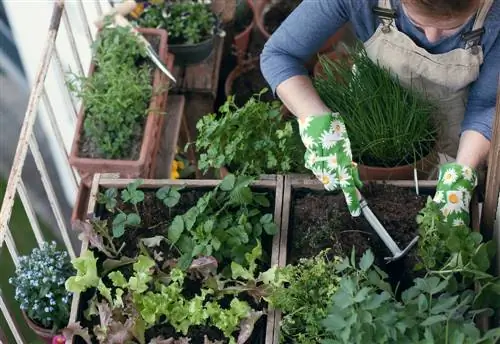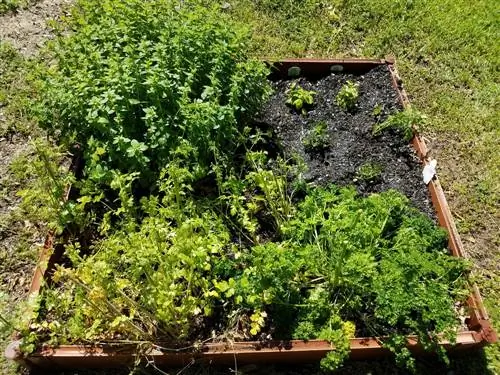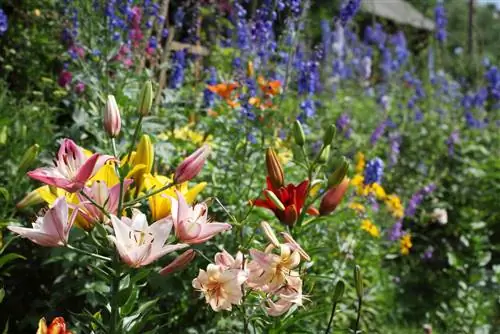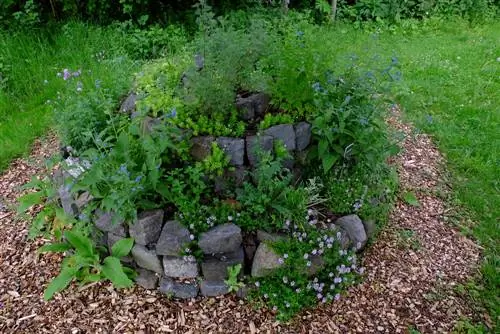- Author admin [email protected].
- Public 2023-12-16 16:46.
- Last modified 2025-01-23 11:21.
Wonderfully smelling, fresh herbs can not only be used in many different ways in the kitchen or for the medicine cabinet, the plants are also a real feast for the eyes in the garden. The beauty of a blooming lavender field is legendary - but rosemary, thyme, sage or chamomile, nasturtium and marigold are in no way inferior. All you need to start a herb garden is the right location, good soil, enough water - and knowledge of the needs of the different plants.
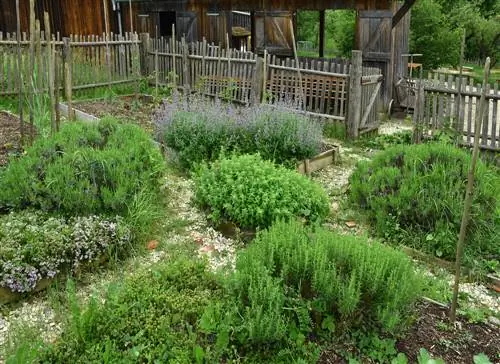
How do I start a herb garden?
To create a herb garden, you need a suitable location, good soil and enough water. Choose sun-loving herbs for sunny areas and shade-tolerant herbs for partially shaded locations. Prepare the soil, create beds or herb spirals and plant the herbs according to your needs.
The right location
Herbs sometimes have very different requirements for their location, although the general rule is that most herbs need a lot of sun and warmth. An ideal location is therefore the south wall of the house or a wall. Hedges also protect against wind and frost damage. Some herbs, such as wild garlic, lovage or mint, however, prefer semi-shady or even shady places. They grow best on the edges of hedges or under trees.
Cultivate non-hardy herbs in pots
Many exotic and some Mediterranean species are not hardy here and are therefore best cultivated in pots. Examples include: lemongrass (Cymbopogon citratus), diptam (Origanum dictamnus), real ginger (Zingiber officiale) or many varieties of rosemary (Rosmarinus officinalis). Herbs grown in pots are best placed on a south or west-facing balcony (or terrace). In addition, they almost always need a bright and frost-free winter quarters.
Which soil do herbs feel comfortable in?
Permeable, medium-nutrient-rich soils are ideal for the he althy growth of almost all herbs. However, some species - especially those from the Mediterranean region - need permeable but rather nutrient-poor soil. So before you start planting and sowing, first find out about the special needs of the selected species and varieties - and, if necessary, prepare your garden soil accordingly.
Prepare the garden soil before planting
Intensive floor care improves all floors and is therefore particularly important. Heavy, fat soils are particularly suitable for very few herbs. They are cold, often compacted and tend to become waterlogged - not exactly ideal for he althy root growth. In order to sustainably improve these soils, air and a lot of humus must be added to the soil. To do this, regularly dig up the soil thoroughly and loosen it with sand. Green manure, regular additions of compost and constant mulching also improve the soil sustainably over the years. Poor sandy soils, on the other hand, can be improved by adding green manure, mulch, rock dust and compost. If the soil is very sandy, adding clay also helps.
Planning an herb garden
Careful planning of the herb garden prevents a lot of trouble later - because if you look in advance which places in the garden are more sunny, which are more shady and where the soil is rather poor and where is more loamy, you can choose the types of herbs Select and plant the right varieties and varieties. After the right location has been found and the desired herbs selected, the design and layout of the beds are planned. There are countless options for this, which depend primarily on the purpose and use of the garden. In kitchen gardens, herb beds are usually created according to formal criteria, while we know mixed cultures with herbs and vegetables from typical cottage gardens. In addition, herbs can also enrich borders or the natural garden by combining them with ornamental plants.
Herbs for the rock garden
Most Mediterranean herbs do not tolerate heavy or even waterlogged soil. They need a lot of warmth in summer and humidity is particularly difficult for them in winter. These species grow much more naturally on poor soils, are more aromatic and produce more active ingredients. Rock garden culture is often the best solution. The location is sunny, the soil is nice and warm and dry. By choosing the stones you can influence the soil; limestone, for example, continuously releases lime and creates good growing conditions for savory, lavender, marjoram, stonecrop, rosemary, sage, thyme, wormwood and hyssop.
Herbs in raised beds
Raised beds are often built on less fertile or stony or sandy soils. The frames made of wooden boards, wicker or stone are filled with compostable materials and good topsoil so that the herbs can grow lushly here. In principle, a raised bed can be built anywhere, the only important thing is that the location has sufficient sunlight. The length of the beds is arbitrary, but they should not be wider than a maximum of one meter - this way the plants can still be easily reached.
Make your own herb spiral
Herb spirals create space for many plants in a small space, with all herbs in their ideal location - dry or moist, lean or humus, sunny or partially shaded. Arranging the plants correctly ensures that everyone can grow in good neighborhood. The shape of the herb spiral is reminiscent of a snail shell. The stones are laid out in a spiral and are layered higher and higher towards the middle. When layering the stones, fill in the soil straight away. Particularly important: Fill in the soil that the herbs you want to plant prefer.
Tip
Dry stone walls are also wonderful for planting herbs. Limestones are particularly suitable for this because they have a positive effect on the acidity of the soil and many herbs also love warm, slightly calcareous soils.



